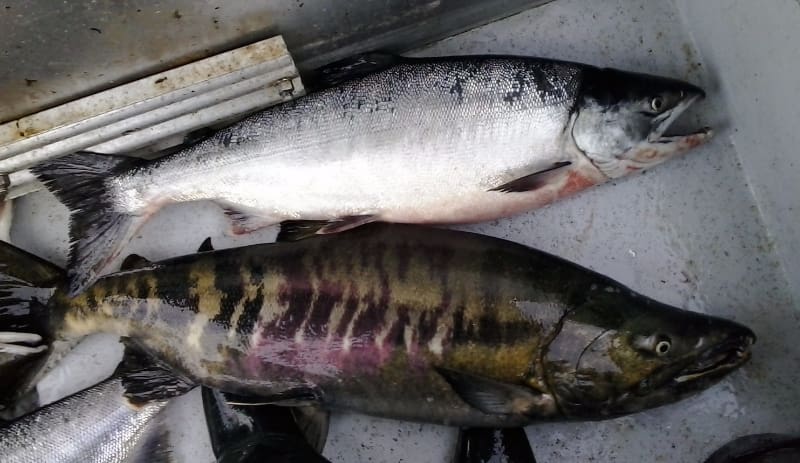Why We Love Chum (Keta) Salmon
RecipesIt’s high time we shed chum’s pet food image! This article by Holistic Nutritionist Melissa Evanson explores the misconceptions that chum isn’t a “good” salmon.

Holistic nutritionist, and Skipper Otto’s member, Melissa Evanson continues her series of nutrition-focused blog posts with a look at our wonderful chum salmon. Have questions about seafood and nutrition? Email us at [email protected] with your questions and Melissa will answer them on our Facebook page.
Chum salmon, also called keta, dog or silverbrite, tends to be the least known of the five Pacific salmon species and receives little love – this may be because of its “dog” moniker, based on sled dogs being fed chum in the north and the sharp dog-like teeth of spawning males. But don’t be fooled, fresh or flash-frozen chum caught during the silverbrite phase (see below) should be on your salmon rotation despite misconceptions that it isn’t a “good” salmon. It’s high time we shed chum’s pet food image!
The backbone of the chum salmon industry has been focused on its highly prized roe (salmon caviar), as well as canned and smoked products. To maximize roe quality and quantity, chum are are often caught later in their life cycle, during their spawning phase, when flesh is softer and less flavourful. This is the chum that’s sometimes fed to the dogs. But when chum salmon is caught in the open-ocean, far from their spawning location (the ‘silverbrite’ phase), the flesh is of high a quality and it’s outward appearance is often indistinguishable from its better known sibling, sockeye.

Nutritionally, chum has a lower fat content than sockeye and chinook, giving it a milder, more delicate flavour while still providing comparable sources of omega-3 fatty acids, as well as essential micronutrients like selenium, niacin and B121. Its lower fat content and milder flavour means chum is well suited for those who may not like the intense flavour of sockeye and for recipes that retain moisture such as curries and chowders. Chum can also make a mean burger and is fantastic grilled or broiled, especially when marinated.
So, how does it really taste?
Well, feel free to ask one of Skipper Otto’s staff members who participated in the 2016 side-by-side blind taste test! Chum was often chosen as staff’s favourite or second favourite out of all five salmon species and some even went as far as calling it “the perfect salmon!”
Bottom line: Given bountiful returns of chum salmon on the central coast, its affordable price point, and highly versatile nature, chum salmon is most definitely not “for the dogs” and should be a staple in your Skipper Otto’s checkout basket.
Here are a few more recipes using chum if you need some inspiration:
- Pan Seared Wild Chum Salmon Fillets
- Roasted Salmon with Tarragon & Butter
- Salmon with Basil, Bacon & Sourdough Crust
| Per 100g cooked | Chum | Sockeye | Chinook | Coho | Pink |
| Calories (kcal) | 237 | 335 | 356 | 247 | 185 |
| Protein (g) | 40 | 42 | 40 | 42 | 32 |
| Total Fat (g) | 7 | 17 | 21 | 8 | 5 |
| Omega-3 (mg) | 949 | 1424 | 2143 | 1114 | 1455 |
| Omega-6 (mg) | 77 | 113 | 136 | 56 | 64 |
| Omega 3:6 | 12 | 13 | 16 | 20 | 23 |
| Vitamin B12 | 58 | 97 | 48 | 83 | 58 |
| Niacin (B3) | 43 | 33 | 50 | 40 | 43 |
| Potassium | 16 | 11 | 14 | 12 | 12 |
| Selenium | 67 | 54 | 67 | 54 | 82 |
| Zinc | 4 | 3 | 4 | 4 | 5 |
------------------------------------------
Melissa Evanson, D. Env., R.H.N.
melissaevanson.com
www.facebook.com/melissaevansonrhn
References:
1 - https://ndb.nal.usda.gov/ndb; http://nutritiondata.self.com
Taste the Skipper Otto difference today! Dive into our unique model and how it works, and learn more about small-scale, independent fishing families.
